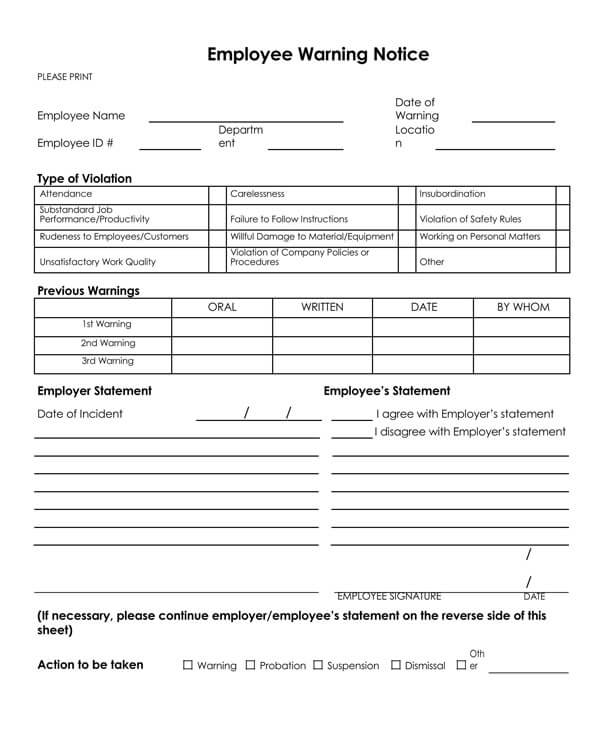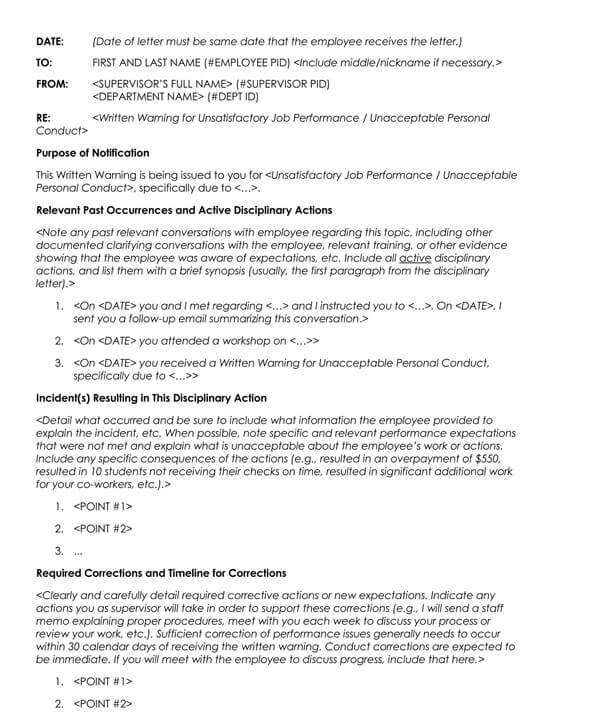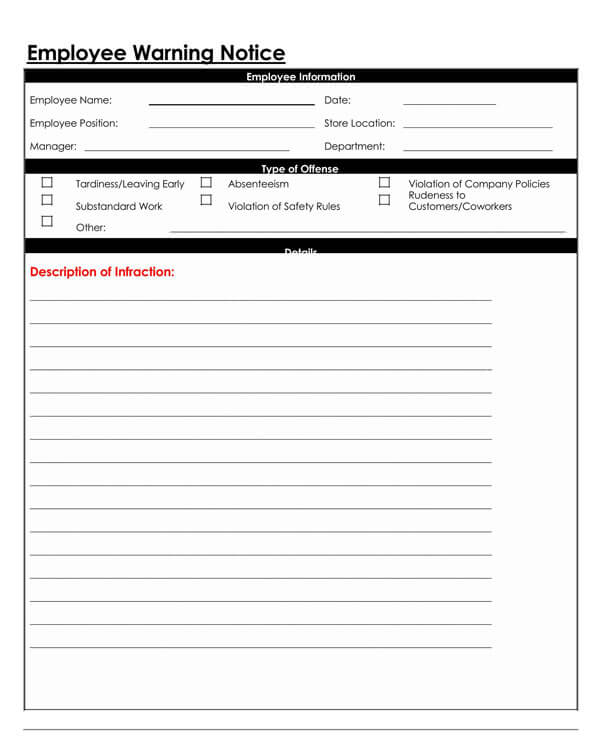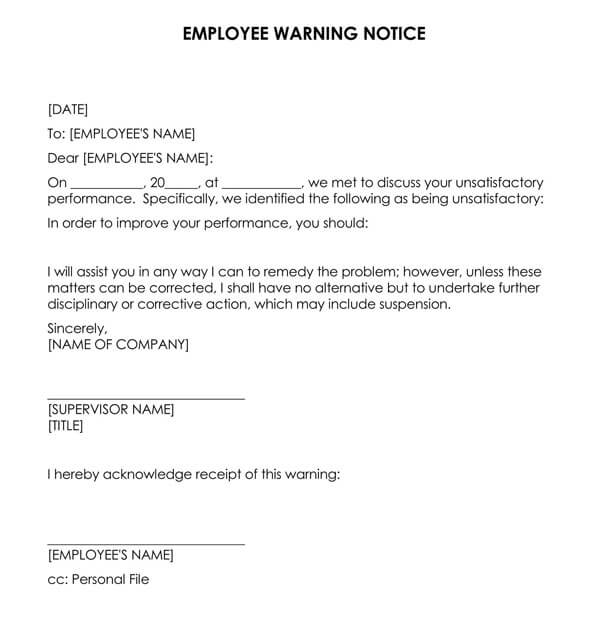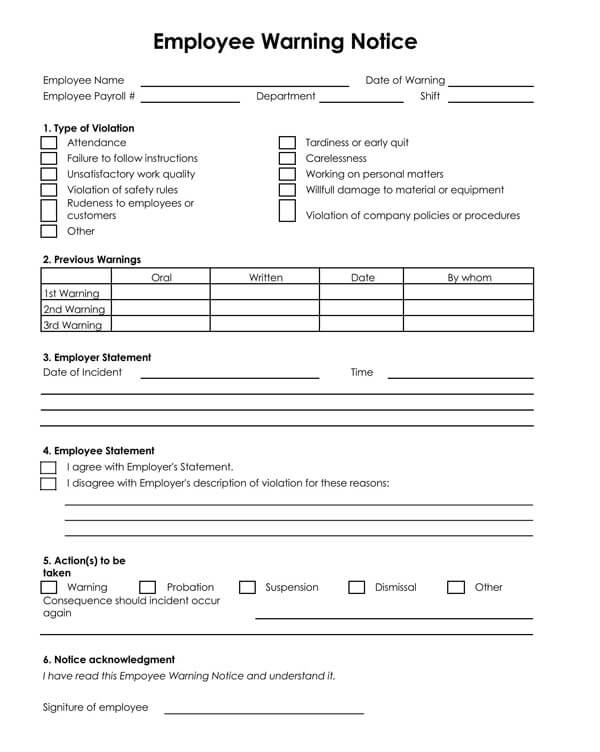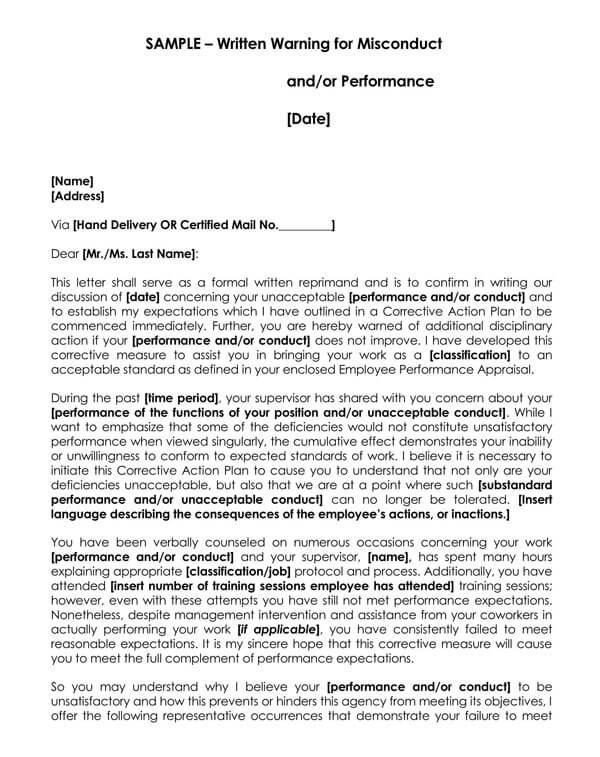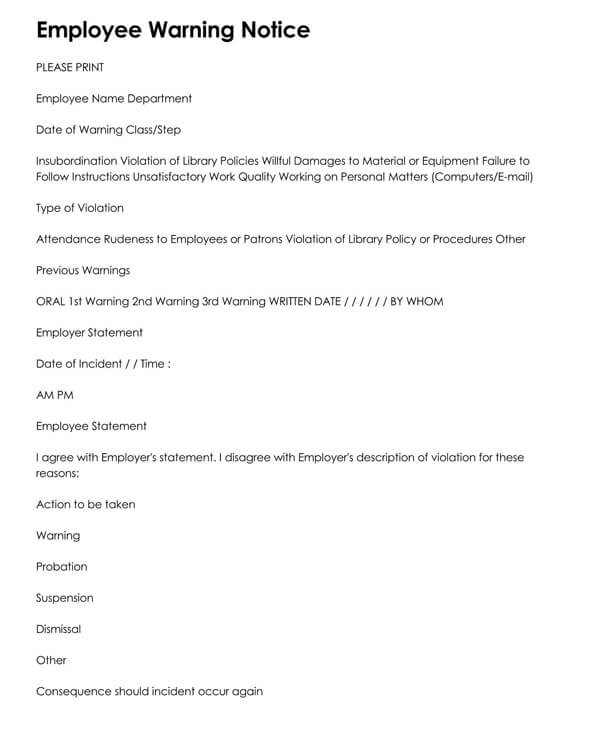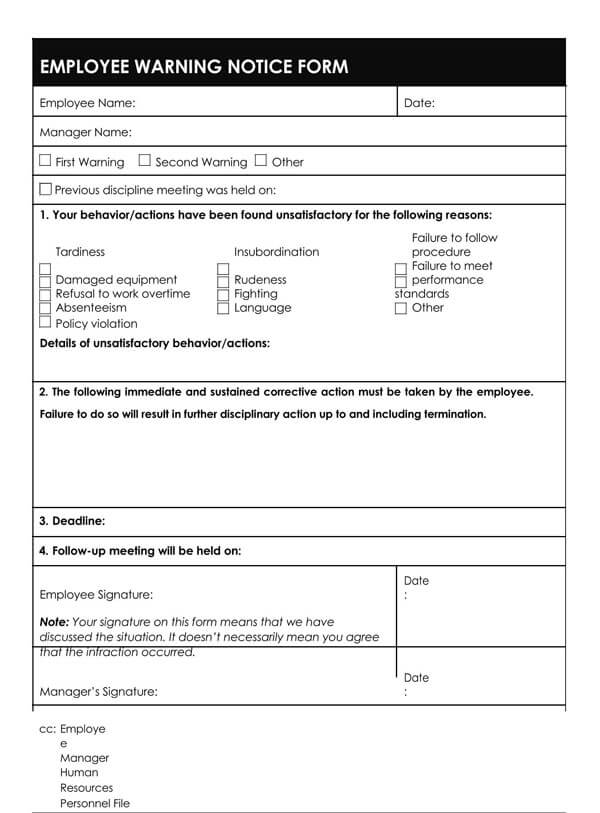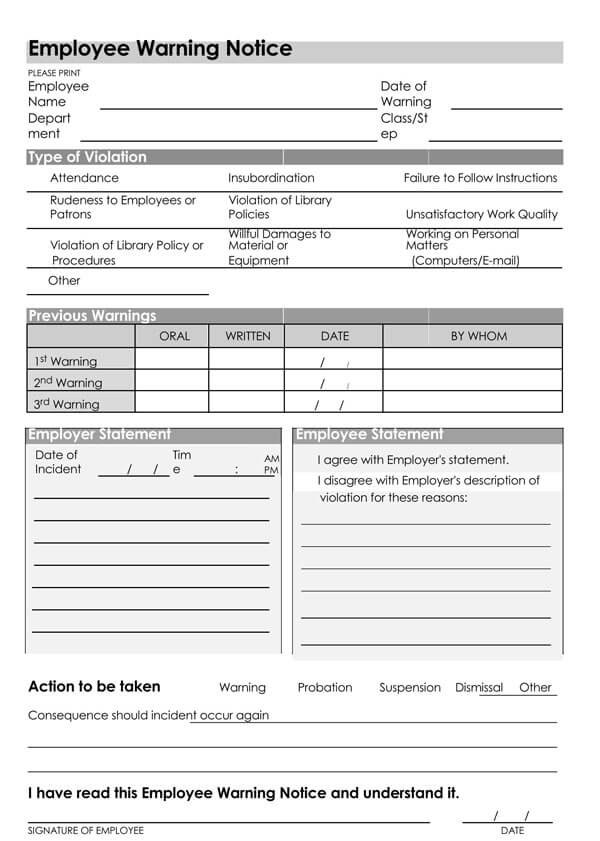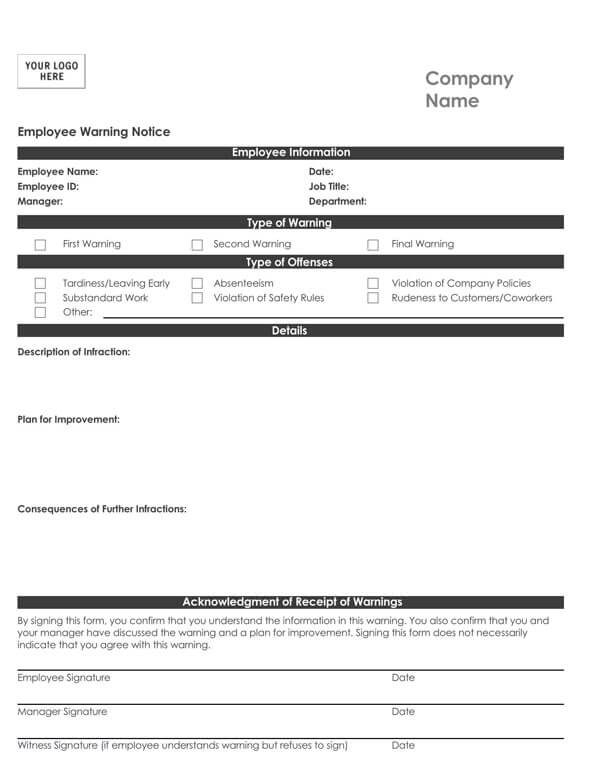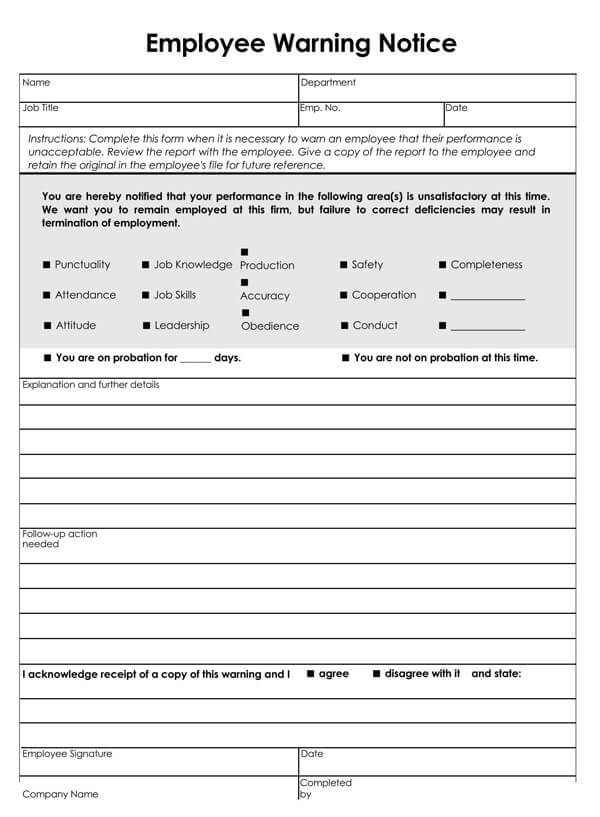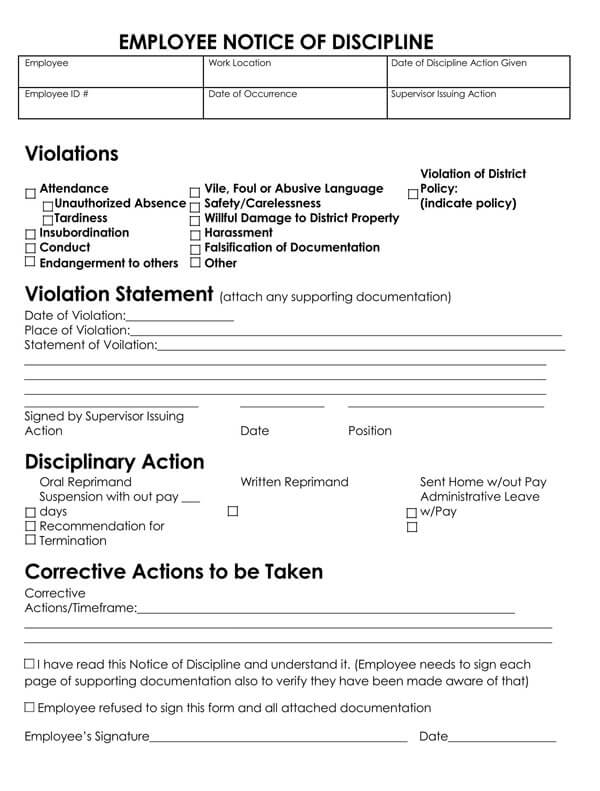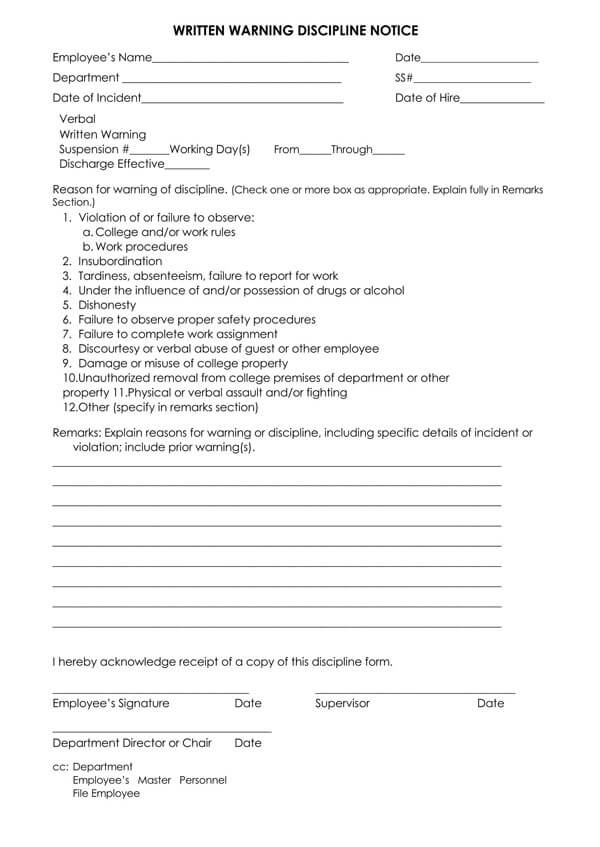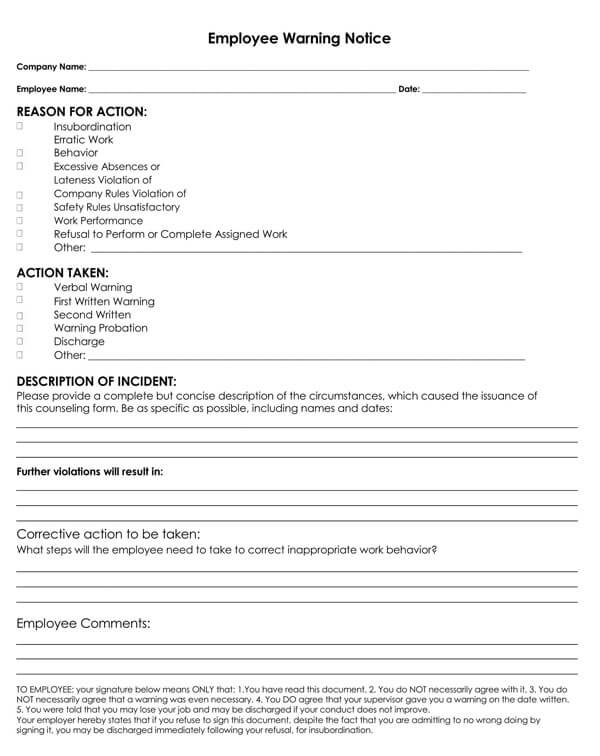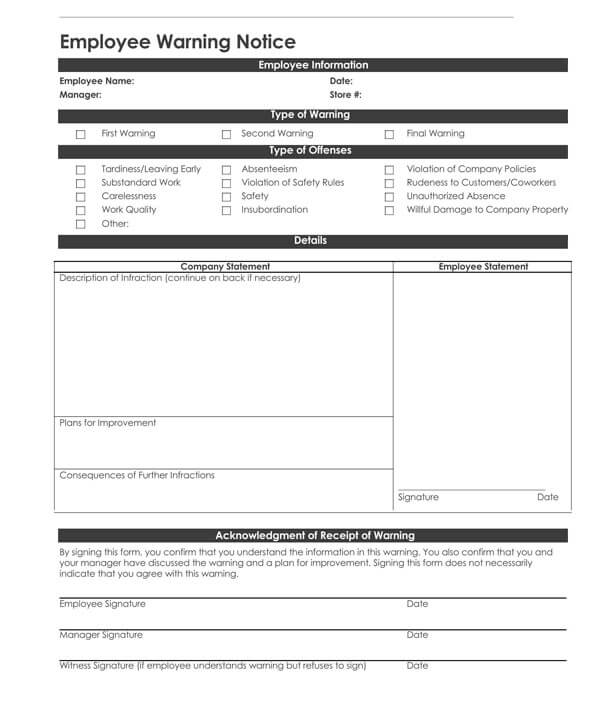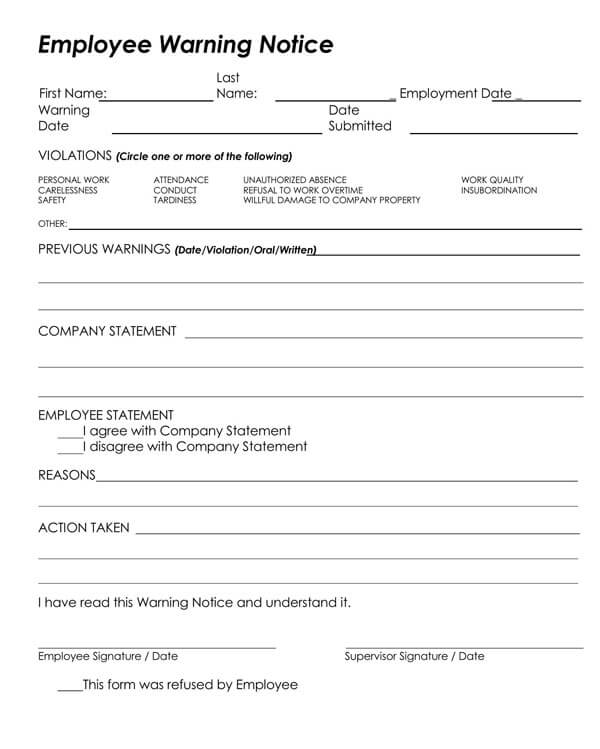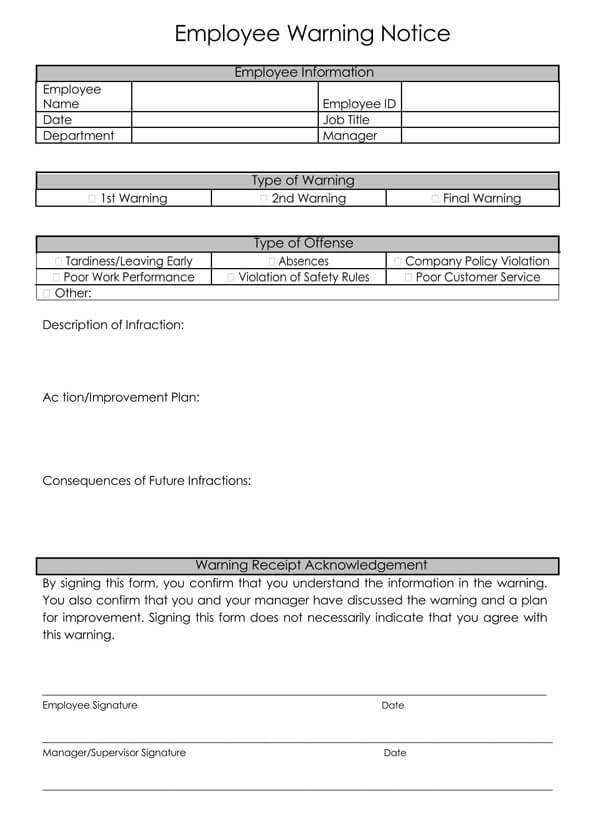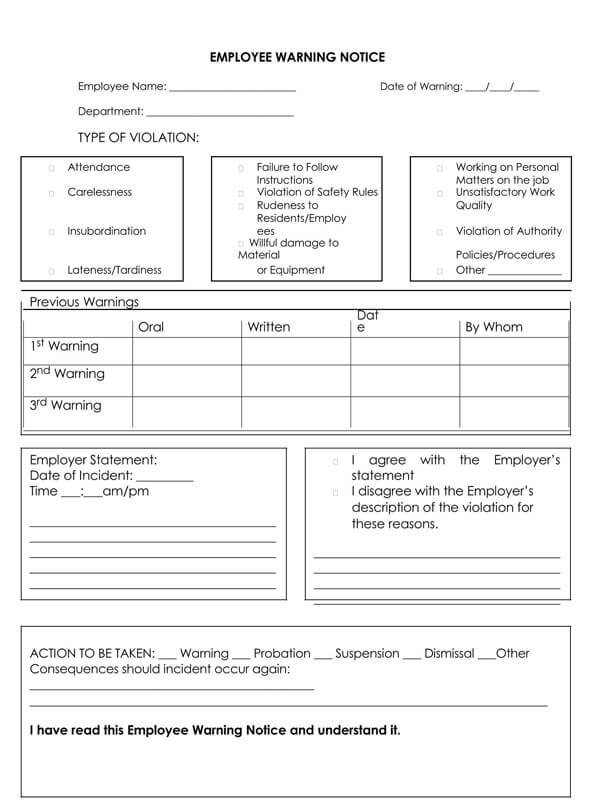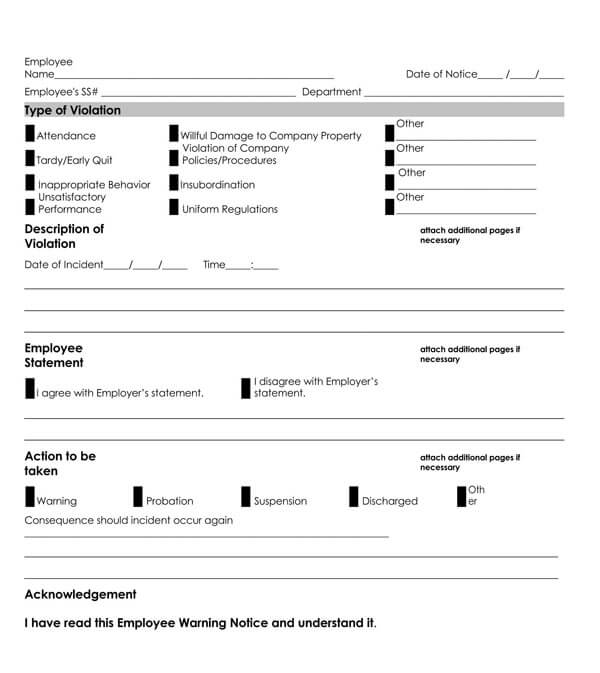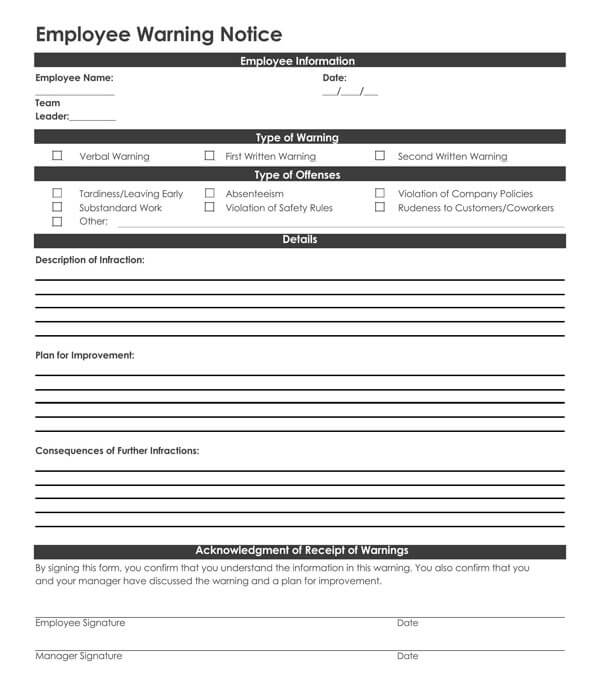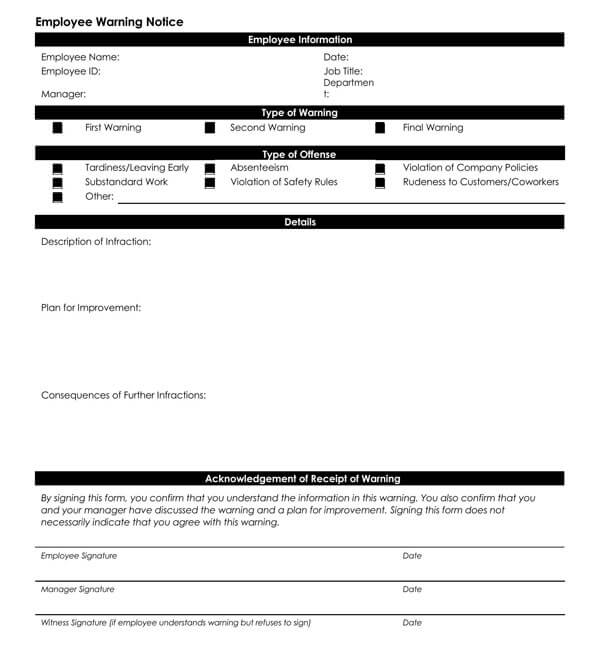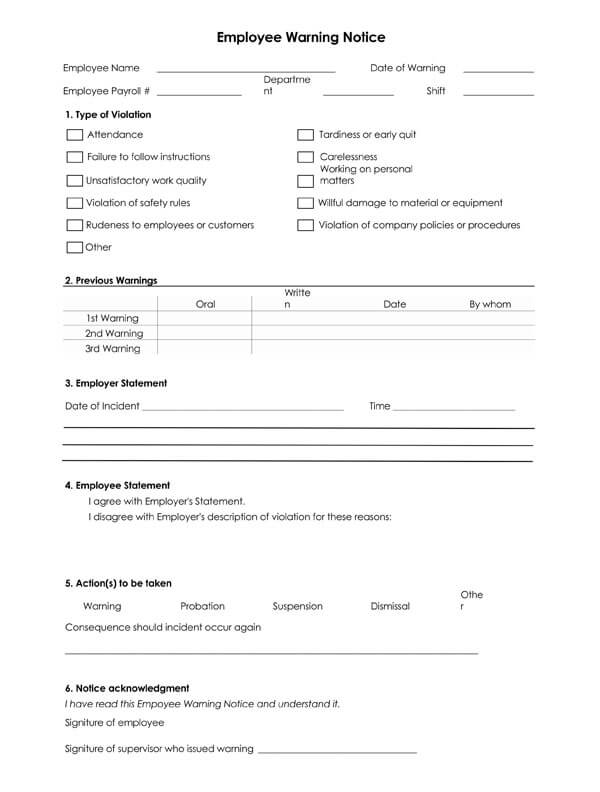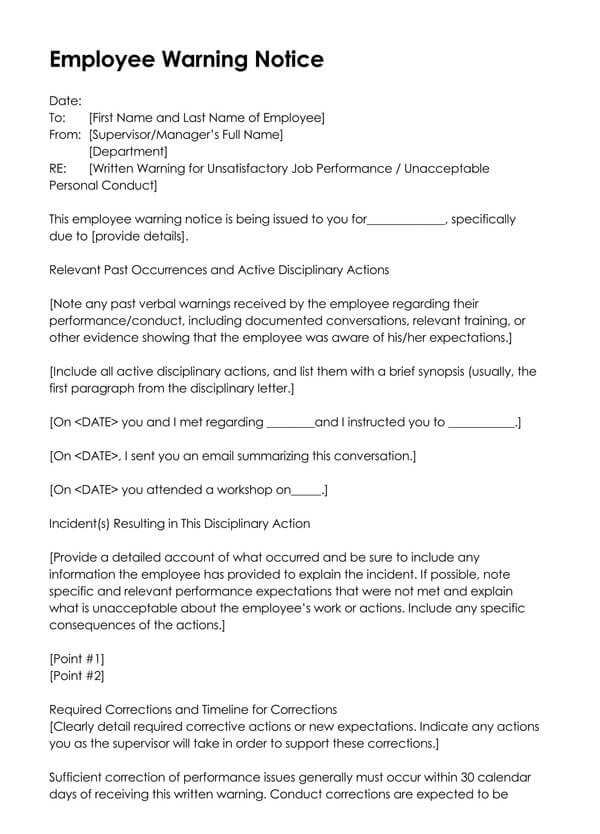An employee warning notice is used to address and confirm an employee’s unacceptable quality of work or inappropriate conduct at work. In many instances, the employer issues an employee warning notice or form after serious consultations with the Employee and unheeded verbal warnings. This allows them a chance to rectify their behavior and attain progress.
The employee warning notice states the wrongdoings of a specific employee, for example, failure to adhere to company rules and set policies, tardiness, or any form of unprofessional behavior.
Why Issuing a Warning Notice is Necessary
State Federal laws do not require companies to issue warning forms to employees, but they are still common in industries and workplaces.
Below are key reasons why you should issue written warning notices to your employees:
To protect your company from lawsuits
Without a warning notice form or letter, company owners and employers put themselves vulnerable to facing wrongful termination claims from their former employees. Suppose you don’t have a record of written warnings; your former employees might file lawsuits against you, claiming that you fired them due to discrimination and biases and not poor performance or gross misconduct. If you have a policy on termination, then it will support you in the event of a legal claim.
Employees awareness through written notice
A well-written employee warning notice or form clearly stipulates what is expected of workers, ways to access resources to meet the set goals, and what befits unacceptable behavior or poor quality of work. Without employee warning notice, your workers may not realize that what they are doing is wrong.
Chance of improvement for employees
When you issue your Employee with a warning letter, you are putting them on notice about their wrongdoings. They know that their job is at risk, and they have a second chance to correct their behavior and improve their performance.
Morale-boost
Being entirely transparent about the workers and workplace issues in general and treating all the employees fairly boosts morale and overall productivity. By issuing a written employee warning notice, the Employee is informed about their wrongdoings, and they know their work may be terminated if they don’t improve. If you fire an employee and feel the termination came from nowhere, it could create employee strife- because employees share everything.
What Should be Included in an Employee Warning Notice
An effective employee warning notice should encompass the following information;
- Company name
- Warning number
- The official name of the Employee, their job title, and the effective date of the employee warning notice
- The full legal name of the manager/supervisor whom the Employee reports to.
- Name of Human Resource representative
- An introductory statement
- A coherent description of the issue at hand and pertinent details regarding the warning notice
- A description of the appropriate policies and guidelines that the Employee is failing to adhere to (Infractions)
- Previous liberties that the company may have provided to the Employees to improve and correct their behavior.
- Expectations of when the Employee must have proven improvement
- Consequences of failure to correct infractions
- Signatures of the Employee affirming the warning notice and agreeing to the corrective action recommended.
- Signatures of the manager and the HR representative or appropriate body that delivered the employee warning notice and date of signing the document
- Follow-up date to ensure progress is being met as expected.
Things to Keep in Mind During the Process of Writing
When an employee’s behavior becomes so inappropriate that you are forced to issue a formal written employee warning notice explaining expectations and outlining consequences, consider the following guidelines for writing a written employee warning notice:
Firstly, identify the problem and provide a coherent description of the incident, including the actual dates, time, what took place, and any other people involved. Try as much as possible to be clear in this section, and don’t let personal subjectivity seep into your recounting of the facts.
Once you have identified the problem, site back to your employment policies and make them clear. If you have an employee handbook in place, copy the policy or policies the Employee broke and include it in your employee warning notice. Suppose you don’t have one, then briefly summarize your company’s policy related to the incident and include it in the warning letter.
The third step involves meeting with the Employee and discussing the issue at hand, going over the allegations point by point. While at it, allow the employee time to react. Spend some quality time trying to layout your company’s expectations and how the employees can achieve these standards. Before concluding the meeting, ensure that the Employee is well aware of precisely what they need to do and the consequences of failing to act accordingly. Remember, it is a great idea to have an HR representative present during the meeting.
After holding a discussion with the Employee and giving him time to improve, but he fails to do so, you can now create your employee warning notice. However, before creating the letter, ensure you consult with others at the management level for useful insights and how to deliver it to the Employee.
Immediately after you have drafted the letter, and you have ensured that all the important information is captured in the document (refer to our heading 6), and you have obtained all the necessary signatures, issue the Employee the warning notice.
Important
It is incredibly advisable to deliver the employee warning notice in person and handle it discreetly with an in-person conversation.
Avoid just putting the notice on the Employee’s desk or sending it via email because it may land on other unintended persons. Also, make sure to retain a copy of the employee warning notice letter for purposes of documentation.
Situations that Require Writing the Notice
Ideally, verbal warnings are one of the first defense lines in curtailing bad behavior in an organization. However, some instances may force a manager or an employer to write their employees a warning notice.
These situations include; when employees constantly exhibit an unwillingness to perform their job duties, attendance issues/tardiness, breach of company policies, insubordination, engaging in illegal behavior, absenteeism, or when employees show inappropriate behavior towards customers.
If employees commit serious violations such as sexual harassment, fraud, or discrimination, take stricter measures such as suspension from work or immediate permanent employment dismissal.
Follow-up and Consequences
Suppose you have already issued your Employee with a first employee warning notice, and they still don’t demonstrate improvement or cease violation of the specific company policies. In that case, you can apply the following consequences in order of escalation.
These include;
- Issuing the Employee with a second verbal warning
- Give them a second documented employee warning notice
- Suspend them from work for one or two weeks depending on your company policies on suspension
- Issue a third and final documented employee warning notice followed by an in-person meeting with the Employee
- If the past warnings, probation, or suspension do not improve behavior or actions, permanent and automatic termination of employment is applied.
Employee Warning Notice Template
[company name]
[Warning number]
[Employee Name]
[Job title]
[Supervisor name]
[HR Representative name]
Date: __
Dear _ [Employee’s full name]
Kindly note that your managing director has notified your HR department that you have committed the following actions that are against our company operations guidelines:
Infraction 1: [Provide a detailed explanation of the violation]
Infraction 2. [If more than one infraction, list down all of them]
According to our records, you were issued with a verbal warning on __ [Date].
Note that as a result of your actions, the following consequences will be applied, in order of escalation, should you demonstrate improvement or cease violation of the company’s policies:
Second verbal warning
Documented warning notice
Job suspension for three months without pay
Third and final notice
Termination of your employment should you fail to improve on your actions
At [Company name] we are very determined to ensure that we offer great service to all our customers and we can only do so with your expert knowledge in the field of [title]. We at __ [company] will always do our best to make sure that you improve your performance in order to meet our quality standards.
Supervisor Signature: ___ [Supervisor’s name]
Date: __
Employee Acknowledgement: I _ Employee’s name] hereby acknowledge that I indeed committed the above infractions. I understand that my actions were against the company’s policy and am able and willing to make the necessary changes to continue my employment with _ [Company name]
Employee’s Signature: _
Date: _______
Employee Warning Notice Sample
Zuri Consultancy Firm Ltd
Warning 002
Employee name: John Mac
Job title: Associate Finance consultant
Reports to: Elizabeth Hudson
HR Representative: Irene Michaelson
Date of issue: 15/03/2021
Dear John Mac,
The management has been informed by your immediate supervisor that you have committed the following infraction against the Zuri Consultancy Firm stipulated company policies:
Infraction 1: frequently being absent from work without your supervisor’s permission, negatively affecting your individual performance and your team’s overall productivity.
You received a verbal warning for the infraction mentioned above on 4/12/2020 and a consequent first written warning for the same behavior on 2/02/2021.
At Zuri Consultancy Firm Limited, we take Monday-Friday attendance of work seriously, and we expect all our employees to comply with this policy. However, you have constantly violated this policy and have exceeded the number of days you can absent yourself from work, despite reprimands.
Because this is your second written warning, the following consequences will be applied, in order of escalation, should you fail to demonstrate improvement or compliance to the company policy on time off:
Third and final written warning
Job suspension without pay for one week
Face an in-person disciplinary meeting
Automatic employment termination.
As the management, we are determined to continue having your expert knowledge as an associate finance consultant within our company, and we are prepared to give you all the necessary support to help you comply with the time off policy.
I am available to discuss any complications that you may be facing that cause you to be absent from work. Don’t hesitate to reach me directly if there is any way I can help you.
Supervisor’s signature: Elizabeth Hudson Date: 15/03/2021
Employee Acknowledgement: I hereby affirm that I have committed the infraction listed above. I am ready and prepared to take necessary corrective action to amend my behavior and continue my employment with the Zuri Consultancy Firm limited.
Employee signature: John Mac Date: 15/03/2021.
Free Employee Warning Notice Templates
Suppose an employee constantly keeps producing substandard work, absents themselves frequently without permission, or ignores safety standards within the workplace. In that case, it is probably good if you issue them with a written employee warning notice. If you are still stuck on what to include in the letter to effectively communicate your issue, download our templates to help you start. Our templates are customizable, downloadable, and printable.
A written warning is essential in getting an employee to acknowledge that they committed wrongdoing and realize the severity of his/her behavior. It can also protect your company against legal suits based on wrongful termination should the situation escalate.
As an employer, when crafting written warnings, ensure that you document the incident in detail and obtain proper signatures. While writing the notice, be sure to check your tone such that you don’t come out as being rude/harsh. Understand your genuine reasons for writing the notice such that you know the right words to use to make it serve the purpose it was intended for.
Tips for Giving Written Warnings
Consider the following tips when issuing written employee warnings notice to remain on the safer side;
- It is wise to issue a verbal warning first: in accordance with employment laws, a formal written employee warning notice should only be issued after a verbal warning, and the Employee has refused/failed to correct the actions requested. It is essential that you plan a meeting with the given Employee and discuss the behavior they need to improve or cease and give them a second chance to show compliance before resolving to issue them with a written notice.
- If you issue a written warning notice, clearly describe infractions: Provide dates, other people involved, and the specific incidents to ensure that the reason for the warning is clear to the Employee to avoid confusion.
- End your written notice on a positive note: Always conclude your written warning letter with a positive statement by stating that the company’s primary goal is to improve its relationship with its employees and chances for mutual growth. This way, the Employee is likely to take the warning positively and try as much as possible to improve their behavior and safeguard their job.
- Issue handbook: Right from introduction of new employees to your organization, issue them with an employee handbook containing information on what is considered an infraction within the workplace in accordance with your stipulated Human Resource policies. Always circle back to these policies while writing the employee warning notice letter.
Frequently Asked Questions
What method should I use to deliver a warning notice to an employee?
First, you can schedule a sit-in meeting with the specific Employee and give them the written employee warning notice and discuss with them plans for future improvement. You can also choose to send them the document via email, with a subject line clearly indicating the warning notice. Alternatively, you can have the document printed and a copy delivered to the Employee by the company’s HR.
What actions constitute a warning versus automatic termination of employment?
Written warnings address general issues such as tardiness, failure to comply with company rules and policies, insubordination, inconsistent work performance, among other issues. However, gross misconduct at the workplace, such as sexual harassment, engaging in fraudulent activities, or verbal and physical violence towards colleagues or supervisors, leads to immediate and automatic employment termination.
What should happen after you issue the warning notice to an employee?
Once you issue an employee with a formal written notice, schedule a discussion with them and discuss future improvement plans. Ensure that you engage them well and listen to their concerns actively, and emphasize your desire to support them fully to improve the situation. After that, give them a timeframe and closely monitor their performance onwards. If you notice any improvement, however slight, praise them for maintaining a positive outlook.
Do you have to sign the warning at work?
Generally, it is a great idea to have a policy system that requires the Employee to be present at the time of issuance of the warning notice. However, this does not necessarily mean that the Employee has to sign the warning at work. But this entirely depends on the employer, who can decide whether they find it necessary to have it signed there and then.
Can you skip a verbal warning?
In cases of gross misconduct or unacceptable quality of work, you do not have to give a verbal warning first. Instead, you can write a final written employee warning notice. However, it is advisable that you make this very clear in your company policies or employee handbook.
Why should I use an employee-written warning form?
Using a written warning form does more than protect your business from harmful lawsuits, boosts your workers’ transparency and morale, and allows your employees to know what is expected of them and what needs to be improved.
What happens when the employee refuses to sign the warning letter?
Suppose an employee refuses to sign the written warning, ask them to submit a signed rebuttal document instead. The rebuttal document should reference the infractions raised in the employee warning notice. Keep the rebuttal document in the Employee’s file with the initially written warning as proof that he/she received a warning.
